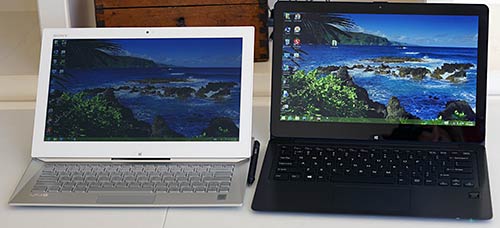|
Home > Laptop Comparisons & Tablet Comparisons> Sony Vaio Flip 13 vs. Sony Vaio Duo 13 Smackdown

Sony Vaio Flip 13 vs. Sony Vaio Duo 13 Comparison Smackdown

Posted November 12, 2013 by Lisa Gade, Editor
in Chief (twitter: @lisagade)
Here's another one of those smackdowns where either way, one company wins. In this case it's Sony with their innovative Windows 8 convertibles, the Sony Vaio Flip 13 and the Vaio Duo 13. The Duo 13 has been on the market a few months longer, but both it and the Flip 13 share the same display and underlying platform. They have Intel 4th generation Haswell ULV CPUs, 4 to 8 gigs of DDR3L RAM and mSATA SSD drives. They both have Sony's 13.3" full HD Triluminos display with N-Trig active digitizers and digital pen support. But the form factors are wildly different.

The Difference is in the Designs
The Sony Vaio Duo 13 has a slider design that makes it easier to use the Ultrabook as a tablet. In fact, in its closed or carrying position, it is a tablet with the screen facing out. That makes it more vulnerable in transport than the Vaio Flip 13 that morphs into a standard laptop with an aluminum lid facing out. The Duo 13 is designed for those who plan to use the device frequently, if not most of the time in tablet mode. The slightly shorter than normal keyboard and abbreviated trackpad are a testament to this. Even in laptop mode, the screen is closer and at a better angle for touch than the Flip 13 in laptop mode. The screen angle however, isn't adjustable, which might annoy some folks.
The Sony Vaio Flip 13 looks at first blush like a standard high end Ultrabook with a metal casing and a slim design. It's unique hinge sits mid-display and you can flip it from notebook to tablet to presentation mode, all the while avoiding the Lenovo Yoga problem of the keyboard resting against your legs or table. For those looking for a laptop first and a tablet second, the Flip 13 is the better choice. Even if you are looking for a tablet first, you can leave the Flip in tablet mode all the time, and it works just as well as the Duo 13.

Same Stuff Inside
If you compare a similarly spec-d Flip and Duo 13, you'll see the same performance since they're running on the same CPUs, Intel integrated graphics, RAM and SSD selections. The Vaio Flip 13 is available with Haswell Intel Core i3, 5 and i7 ULV CPUs, while the Duo 13 is available with Haswell Core i5 and i7 CPUs. Both max out at 8 gigs of RAM and that RAM is soldered onto the motherboard, so you can't upgrade later. The SSD has an mSATA interface.
For those with big budgets and high graphics desires, the Duo 13 is available with a Core i7 plus Intel HD 5000 graphics vs. the HD 4400 on lower level Duo 13 models and the Flip 13. That will net you 5 to 10% improvement in graphics benchmarks and a few frames in 3D games.
Both use the same display panel and these are some of the best full HD 13.3" displays on the market with near full sRGB coverage and 75% of Adobe RGB. Both reach 300 nits of brightness and have excellent contrast. Both have N-Trig active digitizers that work with N-Trig digital pens. The Duo 13 comes with the pen, but many Flip 13 SKUs don't so you'll have to buy it separately for $40.
The Duo 13 and Flip 13 have two USB 3.0 ports, full size HDMI, an SD card slot and a 3.5mm combo audio jack. They have stereo speakers (the Flip 13 gets louder) and mics. They have NFC, dual band WiFi and Bluetooth 4.0 as well as front 720p webcams and rear 8MP cameras.

What's not the Same
Much has been made of the Vaio Duo 13's WiFi, a dual band Broadcom adapter. We've noted a bit lower signal strength but otherwise reliable connections and good data transfer speeds on our Apple Airport Extreme 802.11n network. But there are thousands of wireless routers in homes and offices and several different networks in use (b, g and n). Clearly the machine's WiFi performance is dependent on your router, network type and even building materials. That said, the Sony Vaio Flip 13 uses the solid Intel 7260-N dual band WiFi 802.11n adapter and it gets a stronger signal on our network at greater distances. If you typically use WiFi in weak service areas, the Flip 13 may be a better pick.
Battery life is significantly better on the Sony Vaio Duo 13, and it has a 2x bigger battery. The Duo 13 typically lasts us 9 hours on a charge. The Vaio Flip 13 lasts 6 hours. The Flip 13 would likely have better battery life if the darned fan wasn't on constantly. Even at boot before the internals have a chance to heat up, the fan is whirring away. It's annoying. CPU temps are low, yet the fan is working hard--we hope Sony fixes this with a BIOS update. The Duo 13, even our Core i7 model, is silent unless playing a demanding 3D game like Civ V or converting full HD video for export.
The Duo 13 is available only as a 13.3" machine. The Sony Vaio Flip is available in 13, 14 and 15 inch sizes. For those of you who aren't fond of small laptops, the Flip gains appeal in its bigger sizes, though it becomes harder to use as a tablet as size and weight rise.
The Duo 13 is priced approxmimately $200 higher than the Flip 13 with comparable specs. Both models are available only with 1920 x 1080 full HD Trilumos displays with N-Trig digizers, SSD drives and a minimum of 4 gigs of RAM. Both are available in silver and black.
|

